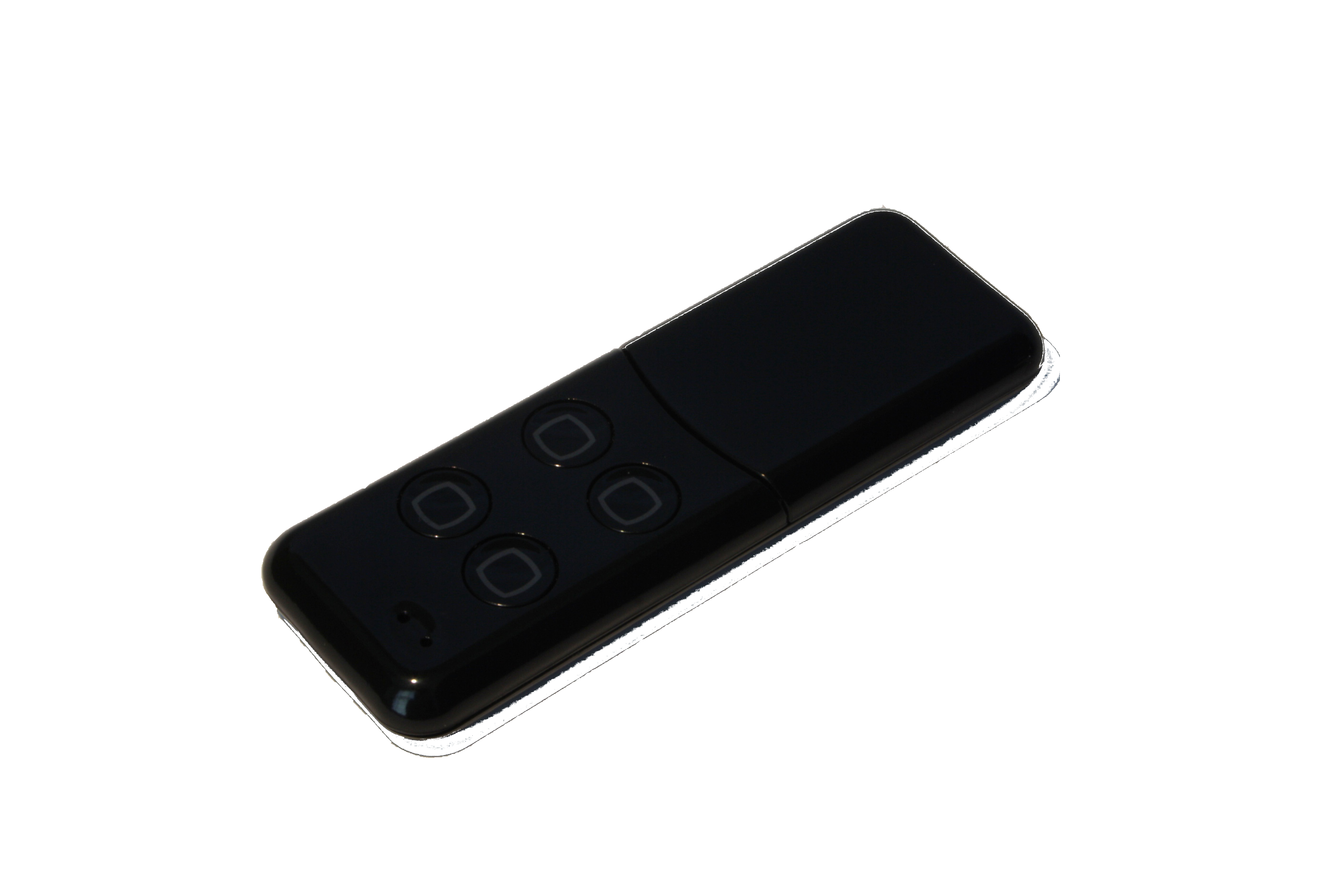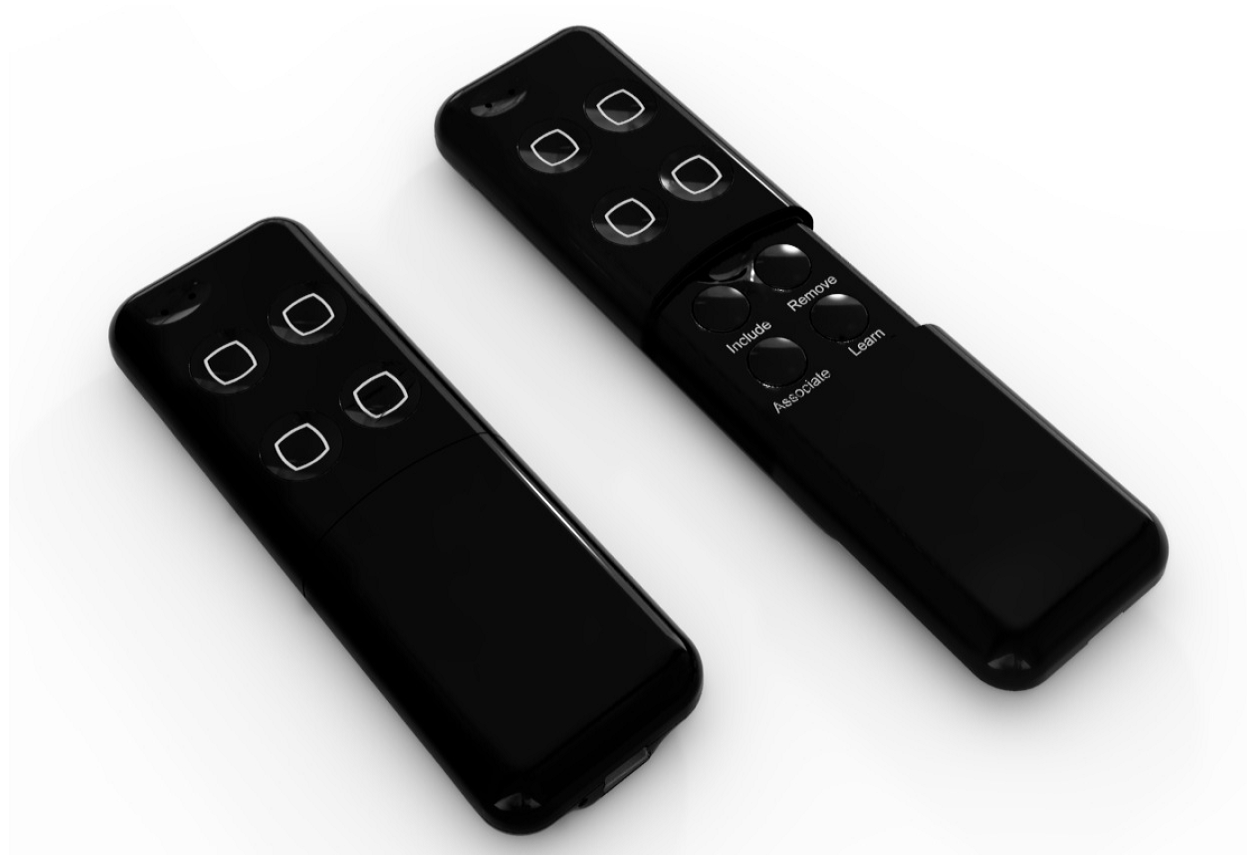
Aeon Labs
Aeonlabs Minimote black
SKU: AEO_MREM_B

Quickstart
This is a
Use Network Management Buttons to include and exclude devices to the remote controls network and use the LEARN button to include the minimote into a different network. Pushing the LEARN button for 5 sec will wake up the device.
Important safety information
Please read this manual carefully. Failure to follow the recommendations in this manual may be dangerous or may violate the law. The manufacturer, importer, distributor and seller shall not be liable for any loss or damage resulting from failure to comply with the instructions in this manual or any other material. Use this equipment only for its intended purpose. Follow the disposal instructions. Do not dispose of electronic equipment or batteries in a fire or near open heat sources.What is Z-Wave?
Z-Wave is the international wireless protocol for communication in the Smart Home. This device is suited for use in the region mentioned in the Quickstart section.
Z-Wave ensures a reliable communication by reconfirming every message (two-way communication) and every mains powered node can act as a repeater for other nodes (meshed network) in case the receiver is not in direct wireless range of the transmitter.
This device and every other certified Z-Wave device can be used together with any other certified Z-Wave device regardless of brand and origin as long as both are suited for the same frequency range.
If a device supports secure communication it will communicate with other devices secure as long as this device provides the same or a higher level of security. Otherwise it will automatically turn into a lower level of security to maintain backward compatibility.
For more information about Z-Wave technology, devices, white papers etc. please refer to www.z-wave.info.
Product Description
The Aeon Labs mini remote control can control a variety of Z-Wave compatible devices such as switches, dimmers, window blinds and motion sensors. The device can include and exclude devices, group them and set and release associations. The mini remote only offers four control buttons for scene selection. Behind a slider there are four more buttons for Z-Wave network control. A non-replaceable but rechargeable battery powers the remote control. Recharging is done on a conventional USB bus using the charging cable provided. The product is in the color black.
Prepare for Installation / Reset
Please read the user manual before installing the product.
In order to include (add) a Z-Wave device to a network it must be in factory default state. Please make sure to reset the device into factory default. You can do this by performing an Exclusion operation as described below in the manual. Every Z-Wave controller is able to perform this operation however it is recommended to use the primary controller of the previous network to make sure the very device is excluded properly from this network.
Reset to factory default
This device also allows to be reset without any involvement of a Z-Wave controller. This procedure should only be used when the primary controller is inoperable.
Press the buttons "Association" and "Learn" together for 10 seconds to reset the device.
Safety Warning for Mains Powered Devices
ATTENTION: only authorized technicians under consideration of the country-specific installation guidelines/norms may do works with mains power. Prior to the assembly of the product, the voltage network has to be switched off and ensured against re-switching.
Installation
The device is ready for use. In case there are no LED signals when hitting the buttons the device needs to be recharged using the USB cable provided.

Inclusion/Exclusion
On factory default the device does not belong to any Z-Wave network. The device needs to be added to an existing wireless network to communicate with the devices of this network. This process is called Inclusion.
Devices can also be removed from a network. This process is called Exclusion. Both processes are initiated by the primary controller of the Z-Wave network. This controller is turned into exclusion respective inclusion mode. Inclusion and Exclusion is then performed doing a special manual action right on the device.
Inclusion
Once the primary controller is turned into inclusion mode press the "Learn" button.
Exclusion
Once the primary controller is turned into inclusion mode press the "Learn" button.
Product Usage
The Minimote has 4 scene control buttons. A scene defines a certain switching state for a number of devices connected to this scene. A single click on the scene button will then turn all these devices into the desired switching state. Below the cover there are 4 dedicated buttons for network management. The Minimote can manage a Z-Wave network as primary controller. However it is also possible to reconfigure all 8 buttons for other functions e.g. activating a scene in a different controller.
Node Information Frame
The Node Information Frame (NIF) is the business card of a Z-Wave device. It contains information about the device type and the technical capabilities. The inclusion and exclusion of the device is confirmed by sending out a Node Information Frame. Beside this it may be needed for certain network operations to send out a Node Information Frame. To issue a NIF execute the following action:
A single click at the
Communication to a Sleeping device (Wakeup)
This device is battery operated and turned into deep sleep state most of the time to save battery life time. Communication with the device is limited. In order to communicate with the device, a static controller C is needed in the network. This controller will maintain a mailbox for the battery operated devices and store commands that can not be received during deep sleep state. Without such a controller, communication may become impossible and/or the battery life time is significantly decreased.
This device will wakeup regularly and announce the wakeup state by sending out a so called Wakeup Notification. The controller can then empty the mailbox. Therefore, the device needs to be configured with the desired wakeup interval and the node ID of the controller. If the device was included by a static controller this controller will usually perform all necessary configurations. The wakeup interval is a tradeoff between maximal battery life time and the desired responses of the device. To wakeup the device please perform the following action:
The device can be woken up manually by pressing the "Learn" button for 5 seconds.
Quick trouble shooting
Here are a few hints for network installation if things dont work as expected.
- Make sure a device is in factory reset state before including. In doubt exclude before include.
- If inclusion still fails, check if both devices use the same frequency.
- Remove all dead devices from associations. Otherwise you will see severe delays.
- Never use sleeping battery devices without a central controller.
- Dont poll FLIRS devices.
- Make sure to have enough mains powered device to benefit from the meshing
Association - one device controls an other device
Z-Wave devices control other Z-Wave devices. The relationship between one device controlling another device is called association. In order to control a different device, the controlling device needs to maintain a list of devices that will receive controlling commands. These lists are called association groups and they are always related to certain events (e.g. button pressed, sensor triggers, ...). In case the event happens all devices stored in the respective association group will receive the same wireless command wireless command, typically a 'Basic Set' Command.
Association Groups:
| Group Number | Maximum Nodes | Description |
|---|---|---|
| 1 | 5 | Scene 1 |
| 2 | 5 | Scene 2 |
| 3 | 5 | Scene 3 |
| 4 | 5 | Scene 4 |
Special Operations as Z-Wave Controller
As long as this device is not included into a Z-Wave network of a different controller it is able to manage its own Z-Wave network as primary controller. As a primary controller the device can include and exclude other devices in its own network, manage associations, and reorganize the network in case of problems. The following controller functions are supported:
Inclusion of other devices
Communication between two Z-Wave devices only works if both belong to the same wireless network. Joining a network is called inclusion and is initiated by a controller. The controller needs to be turned into the inclusion mode. Once in this inclusion mode the other device needs to confirm the inclusion - typically by pressing a button.
If current primary controller in your network is in special SIS mode this and any other secondary controller can also include and exclude devices.
To become primary a contoller have to be resetted and then include a device.
Click the "Inclusion" button to start the inclusion mode.
If inclusion of a new device fails, first exclude it from its previous network or reset it.
Exclusion of other devices
The primary controller can exclude devices from the Z-Wave network. During exclusion the relationship between the device and the network of this controller is terminated. No communication between the device and other devices still in the network can happen after a successful exclusion. The controller needs to be turned into the exclusion mode. Once in this exclusion mode the other device needs to confirm the exclusion - typically by pressing a button.
Attention: Removing a device from the network means that it is turned back into factory default status. This process can also exclude devices from it's previous network.
Click the "Exclusion" button to start the exclusion mode.
Attention: Removing a device from the network means that it is turned back into factory default status. This process can also exclude devices from its previous network.
Shift of Primary Controller Role
The device can hand over its primary role to another controller and become secondary controller.
The primary shift is initiated on the device by pressing the "Learn" button.
Management of Association in the controller
- Press the scene button the new device shall be associated with and keep this button pressed.
- Issue a Node Information Frame from the target device. This is usually done by single or triple click a button. Please refer to the manual of this device how to issue a NIF.
- Before releasing the scene button turn the device into the desired state. After the button is released the minimote will detect the status of the device and store it in the scene.
To delete a device from a scene repeat the process for the scene where the device was already associated with.
Configuration Parameters
Z-Wave products are supposed to work out of the box after inclusion, however certain configuration can adapt the function better to user needs or unlock further enhanced features.
IMPORTANT: Controllers may only allow configuring signed values. In order to set values in the range 128 ... 255 the value sent in the application shall be the desired value minus 256. For example: To set a parameter to 200 it may be needed to set a value of 200 minus 256 = minus 56. In case of a two byte value the same logic applies: Values greater than 32768 may needed to be given as negative values too.
Parameter 241: Mode of Button 1 (upper left)
Defines the switching mode of Button 1 Size: 1 Byte, Default Value: 00
| Setting | Description |
|---|---|
| 00 | Factory Default |
| 01 | Scene Mode |
| 02 | Add Mode |
| 03 | Remove Mode |
| 04 | Association Mode |
| 05 | Learn Mode |
Parameter 242: Mode of Button 2 (upper right)
Defines the switching mode of Button 2 Size: 1 Byte, Default Value: 00
| Setting | Description |
|---|---|
| 00 | Factory Default |
| 01 | Scene Mode |
| 02 | Add Mode |
| 03 | Remove Mode |
| 04 | Association Mode |
| 05 | Learn Mode |
Parameter 243: Mode of Button 3 (lower left)
Defines the switching mode of Button 3 Size: 1 Byte, Default Value: 00
| Setting | Description |
|---|---|
| 00 | Factory Default |
| 01 | Scene Mode |
| 02 | Add Mode |
| 03 | Remove Mode |
| 04 | Association Mode |
| 05 | Learn Mode |
Parameter 244: Mode of Button 4 (lower right)
Defines the switching mode of Button 4 Size: 1 Byte, Default Value: 00
| Setting | Description |
|---|---|
| 00 | Factory Default |
| 01 | Scene Mode |
| 02 | Add Mode |
| 03 | Remove Mode |
| 04 | Association Mode |
| 05 | Learn Mode |
Parameter 245: Mode of Button 5 (marked as Include)
Defines the switching mode of Button 5 Size: 1 Byte, Default Value: 00
| Setting | Description |
|---|---|
| 00 | Factory Default |
| 01 | Scene Mode |
| 02 | Add Mode |
| 03 | Remove Mode |
| 04 | Association Mode |
| 05 | Learn Mode |
Parameter 246: Mode of Button 6 (marked as Exclude)
Defines the switching mode of Button 6 Size: 1 Byte, Default Value: 00
| Setting | Description |
|---|---|
| 00 | Factory Default |
| 01 | Scene Mode |
| 02 | Add Mode |
| 03 | Remove Mode |
| 04 | Association Mode |
| 05 | Learn Mode |
Parameter 247: Mode of Button 7 (marked as Association)
Defines the switching mode of Button 7 Size: 1 Byte, Default Value: 00
| Setting | Description |
|---|---|
| 00 | Factory Default |
| 01 | Scene Mode |
| 02 | Add Mode |
| 03 | Remove Mode |
| 04 | Association Mode |
| 05 | Learn Mode |
Parameter 248: Mode of Button 8 (marked as LEARN)
Defines the switching mode of Button 8 Size: 1 Byte, Default Value: 00
| Setting | Description |
|---|---|
| 00 | Factory Default |
| 02 | Add Mode |
| 03 | Remove Mode |
| 04 | Association Mode |
| 05 | Learn Mode |
Technical Data
| Dimensions | 0.0340000x0.1000000x0.0110000 mm |
| Weight | 30 gr |
| Hardware Platform | ZM3102 |
| EAN | 1220000010260 |
| IP Class | IP 20 |
| Device Type | Remote Control - Simple |
| Generic Device Class | Portable Controller |
| Specific Device Class | Portable Controller |
| Firmware Version | 01.00 |
| Z-Wave Version | 02.4a |
| Certification ID | ZC08-10080006 |
| Z-Wave Product Id | 0086.0000.0000 |
| Frequency | Europe - 868,4 Mhz |
| Maximum transmission power | 5 mW |
Supported Command Classes
- Basic
- Association
- Version
- Switch All
- Manufacturer Specific
- Configuration
- Meter
- Switch Binary
- Switch Battery
Explanation of Z-Wave specific terms
- Controller — is a Z-Wave device with capabilities to manage the network. Controllers are typically Gateways,Remote Controls or battery operated wall controllers.
- Slave — is a Z-Wave device without capabilities to manage the network. Slaves can be sensors, actuators and even remote controls.
- Primary Controller — is the central organizer of the network. It must be a controller. There can be only one primary controller in a Z-Wave network.
- Inclusion — is the process of adding new Z-Wave devices into a network.
- Exclusion — is the process of removing Z-Wave devices from the network.
- Association — is a control relationship between a controlling device and a controlled device.
- Wakeup Notification — is a special wireless message issued by a Z-Wave device to announces that is able to communicate.
- Node Information Frame — is a special wireless message issued by a Z-Wave device to announce its capabilities and functions.